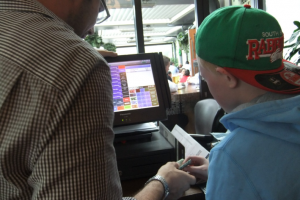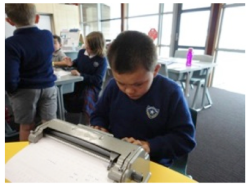
Figure 1 Fingers in correct position
Kohl is a five year old boy who is blind and is attending his local primary school. He transitioned from preschool to primary school in term one this year. He has settled into the classroom routines very well.
Here Marg Crosswell, BLENNZ Resource Teacher of Vision who works alongside Kohl explains his transition and the process of developing pre-braille skills.
In Figure 1 Kohl has his fingers in the correct position on the Mountbatten brailler. Continue Reading →

Figure 1 Emris paying for his restaurant lunch
Emris and Heaven, two 13 year old Intermediate school students with Albinism, needed further development of their social confidence and social skills.
Their Resource Teachers Vision Viv Nuku and Jacqueline Killip developed a social skills programme based upon research which identifies the positive outcomes of sharing social interactions for students with Albinism.
In figure 1 Emris paying for his restaurant lunch. Continue Reading →

Figure 1 – Ethan is brailling at school
Ethan is a 9 year old student currently in Year 4 and attends his local school. He has a significant eye condition which greatly impacts on his accessing the curriculum especially with literacy.
Ethan is able to use enlarged readers and worksheets at some points during the school day but can become visually fatigued.
Marg Crosswell talks about how Ethan’s main goal for this year has been to learn braille and so he has been practising brailling the alphabet on the Perkins brailler (figure 1). Continue Reading →

Figure 1 Identifying tactile 2-D shapes
James is an 8-year-old braille user who is in a mainstream setting at his local primary school.
Sue Fletcher, BLENNZ Resource Teacher: Vision, describes how she introduced James to tactile drawings, maps and diagrams using a Sewell Drawing Kit. In figure 1 James is identifying tactile 2D shapes.
The purpose of the programme was to extend James ability to interpret 2-dimensional images to assist his understanding of maps and of maths and science diagrams used later in secondary schools. Continue Reading →




